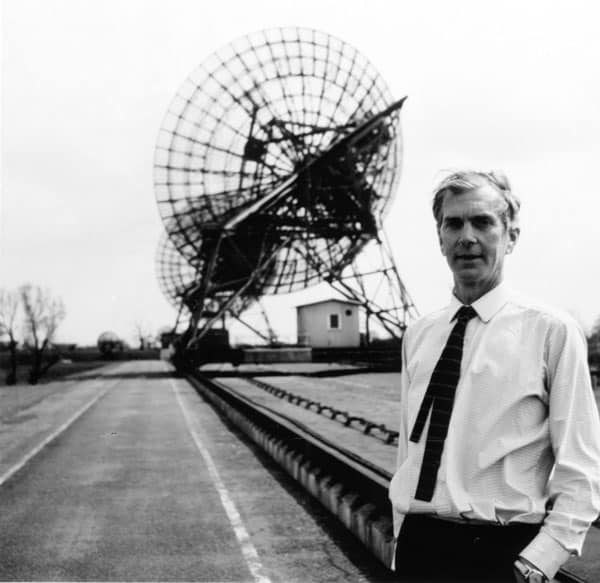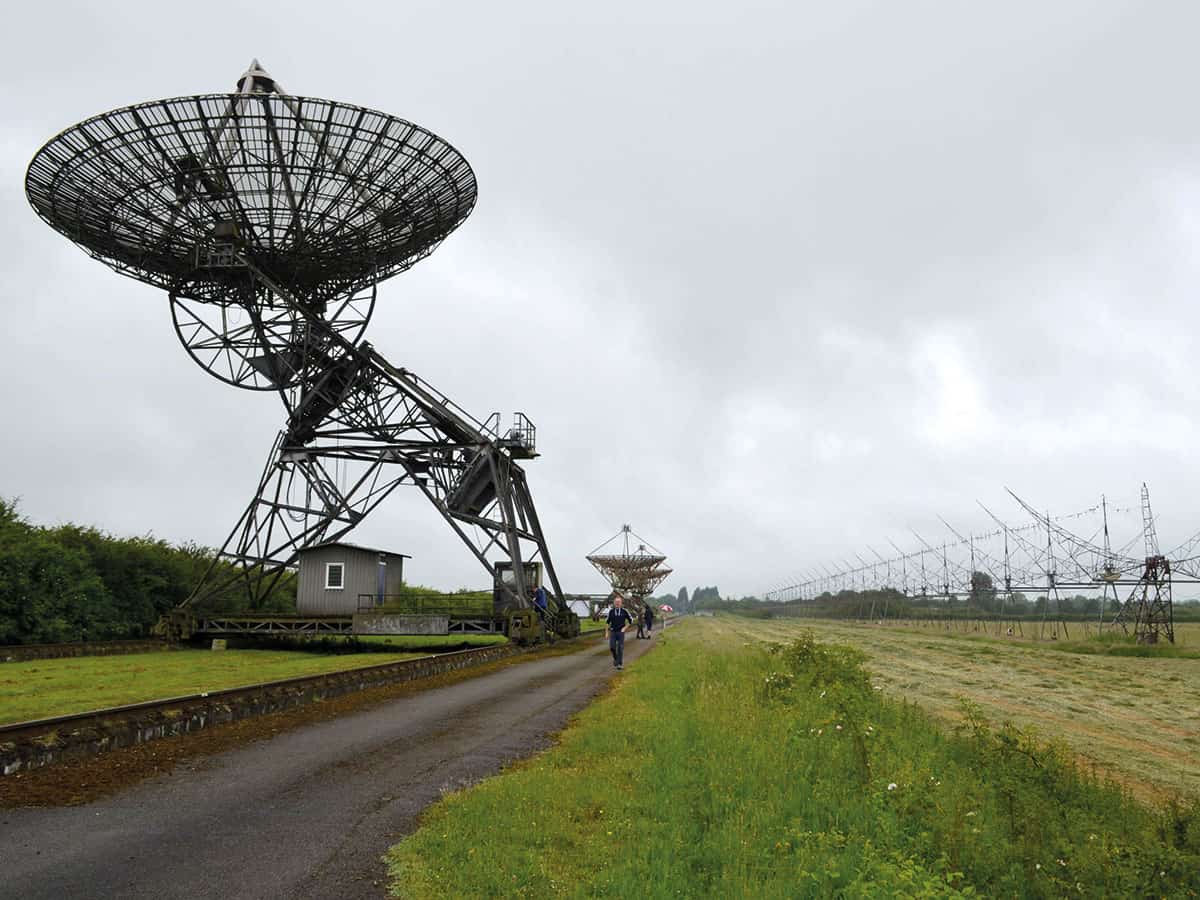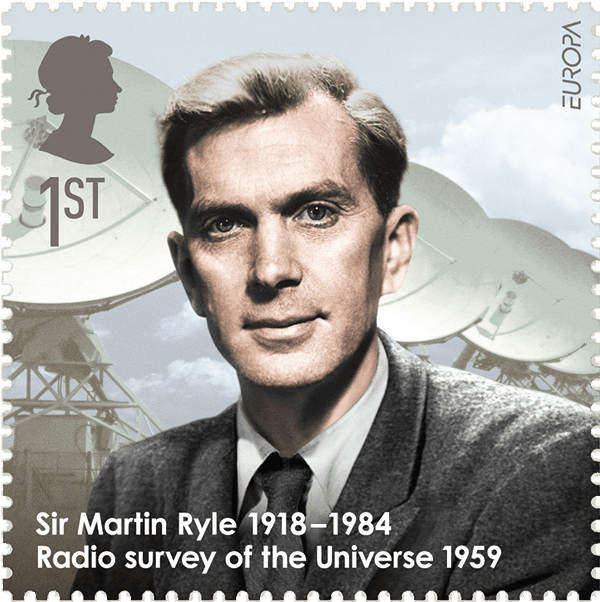Born 100 years ago this month, Martin Ryle was more than just a Nobel-prize-winning astronomer. Alan Cottey takes a fresh look at the life of a brilliant and conflicted scientist who was also a visionary about the human use of energy
Martin Ryle, who was born a century ago on 27 September 1918, was one of the most successful scientists of his generation. In a glittering career, he was granted many of the most prestigious awards and appointments a scientist may gain. Apart from sharing the 1974 Nobel Prize for Physics with his University of Cambridge colleague Antony Hewish, Ryle was a fellow of the Royal Society and professor of radio astronomy at Cambridge. He served as Astronomer Royal and was knighted in 1966.
These recognitions were for his pioneering work in radio astronomy, to which he devoted himself with intensity, creativity, speedy physical insight, charismatic leadership and practical engineering skill. Ryle recognized the potential of radio interferometry, built successively larger interferometers, and applied the new instruments to astrophysics and cosmology. He received his share of the Nobel prize for his “observations and inventions, in particular of the aperture synthesis technique”, which mixes signals from an array of small detectors to yield images with the same angular resolution as an instrument the size of the entire collection.
Ryle recognized the potential of radio interferometry, built successively larger interferometers, and applied the new instruments to astrophysics and cosmology
For various reasons, though, Ryle moved away from astronomy in the 1970s. He became a harsh critic of both nuclear energy and nuclear weapons, and a strong advocate of renewable energy – especially wind energy – as well as of energy storage and heat insulation. Despite ill health, Ryle and a team of close colleagues produced three short papers on energy use. While these publications might seem a drop in the ocean compared with the vast amount of R&D carried out in the intervening four decades, I believe Ryle’s ideas are still important – and that some of his programmes should be taken much further than they have to date.
“An excessively conscientious fellow”
Born in the English coastal resort of Brighton, Ryle came from a liberal intellectual family. His mother was born in South Africa to Irish parents, and Ryle is described in the Biographical Memoirs of the Royal Society as having absorbed something of his mother’s “typically Irish antipathy to The Establishment”. Members of his family also relate Ryle’s passionate nature to his Celtic heritage. His father was a distinguished physician and highly idealistic.

From an early age, Ryle developed useful practical skills in woodworking and amateur radio. In 1936 he went to the University of Oxford, graduating with a first-class degree in physics in the summer of 1939. It was just before the outbreak of the Second World War and Ryle soon found himself contributing to the British military effort, working on radar counter-measures at the Telecommunications Research Establishment. Radar was to play a vital role in the war – especially for Britain – and Ryle’s abilities flourished.
A team leader at just 23, Ryle was an inventive worker who completed urgent technical developments at great speed. He inspired loyalty in his team and learned how to get what he needed from those above him – skills that were to serve him well in his illustrious post-war research career. He hated war but felt equally keenly the need to defeat fascism, and worked himself to near-exhaustion. When Ryle visited his parents in 1941, his father was so alarmed about his health that he wrote privately to his son’s boss, the radio physicist J A (Jack) Ratcliffe. (In the small world of leading British intellectuals of that time, people knew each other.) In the letter, which is in Ryle’s papers at the Churchill Archives Centre in Cambridge, his father advises that Ryle be given “two or three weeks leave pretty soon”, fearing otherwise that the “excessively conscientious fellow…may crack up more seriously”.
In some respects, Ryle had a “good” war but with the conflict over, he was adamant he did not want to continue in military science. Almost everyone involved in that gruelling war felt a strong desire to put it behind them and to build a better world (even if almost everyone soon relapsed, to a greater or lesser extent, into conventional behaviour). For Ryle, astronomy seemed about as far away as he could get.
War is over?
In 1945 Ryle returned to Cambridge to resume his pre-war graduate studies under Ratcliffe, who initially suggested that he should study the ionosphere. But Ryle was not happy and before long Ratcliffe suggested examining solar radio emissions instead. Many items of captured German radar equipment were offered to university research groups and Ryle knew what he wanted from the spoils of war – two large Würzburg radars and a quantity of low-loss coaxial cable – which suggests that he may already have had radio interferometry in mind.
Despite his anti-war idealism, however, Ryle continued his association with the Atomic Energy Research Establishment and the Services Electronics Research Laboratory. Correspondence in the Ryle papers shows he had good relations with both. He also worked with the Admiralty Surface Weapons Establishment on sonic radar (sonar), which led to one of Ryle’s numerous important innovations – the phase-switching interferometer. Later, though, Ryle dissociated himself from the military world. In 1953 he ended his links with the science advisory committee of the Ministry of Supply, which allocated equipment to the armed forces. Ryle also returned secret papers.
With his skills extended by war experience, Ryle quickly became the world’s leading pioneer of radio astronomy. His group at Cambridge developed much of the relevant science, as documented, for example, in An Introduction to Radio Astronomy (3rd ed.) by Bernard Burke and Francis Graham-Smith (2010). From today’s perspective, one might wonder if Ryle really was so special. Surely a radio interferometer is simply an optical interferometer adapted to work at longer wavelengths? After all, Albert Michelson had determined the first ever diameter of a star (apart from the Sun) using an optical interferometer back in 1920.
In fact, the “adaptation” involved important scientific insights made by Ryle (notably aperture synthesis and the related Earth-rotation synthesis technique) and significant developments in telecommunications and data-processing. Furthermore, in 1945 when Ryle started the interferometric approach to what would become known as radio astronomy, there was a wide gulf – both conceptual and professional – between “radio” and “astronomy”. The former meant antennas and was practised by electrical engineers; the latter meant optical telescopes and was practised by astronomers.

State of conflict
Within his group of radio astronomers at Cambridge, Ryle inspired great loyalty and love. But his brilliance, ambition and idealism were mixed with impatience that often led to explosive – and occasionally violent – outbursts. Once, during the war, he was called in to a small meeting with Lord Cherwell – a friend and scientific adviser of prime minister Winston Churchill – to discuss a pet scheme of Cherwell. Undaunted by his lofty companions, Ryle was not afraid to remark that the idea was “utter bloody rubbish”.
The strongly tribal nature of his research group led to something of a “fortress Cambridge” mentality that triggered disputes with outsiders. Ryle also did not enjoy attending or travelling to meetings and conferences, despite the numerous prestigious positions he held that put him in much demand. These attitudes were at odds with a note found in Ryle’s papers, which opens with: “Our world is one”. That may have been his credo, but Ryle’s idealism did not always match the reality.
In October 1957 the world, and especially the US, was startled by the Soviet Union’s launch of the first artificial Earth satellite. Ryle was interested in the technical possibilities, publishing a proposal in 1958 with Graham Smith on the use of artificial satellites as a navigation aid.
A few years later, the pair led astronomers in protest against the US’s “rainbow-bomb” experiments – explosions of nuclear weapons at high altitude. They joined radio astronomers around the world in opposing the disturbance of the Earth’s van Allen belts and the consequent disruption of radio astronomical observations. This lobbying was, however, far from Ryle’s passionate denunciations of his later years.
An urgency for energy
Ryle’s doubts that he had begun to have about his escape to astronomy came to a head in the 1970s. By then radio astronomy had become “big science” practised internationally by large groups and, although Ryle was in principle in favour of international co-operation, it did not fit his style. Now in his 50s, Ryle’s health began to deteriorate and he had at least one operation for lung cancer. He gradually became less involved with radio astronomy and, with a few close colleagues, began to carry out research into wind energy.
Back in the 1970s, our views on energy were very different to now. In particular, it was generally believed that oil and gas reserves would be exhausted within a few decades. And while a few scientists took anthropogenic climate change seriously, most – if they had even heard of the idea – considered it too speculative to pronounce upon. Ryle, though, entered the energy debate with characteristic urgency. He insisted that burning oil and gas for energy (heat, electricity or motive power) must be curtailed, drastically and quickly. These precious resources, he argued, should be reserved as raw feedstock to make chemical products, especially plastics.
Feeling urgent action was essential, Ryle recommended our top priority should be to use energy more efficiently. Little had been done on this at the time and Ryle believed it would be quick and easy to improve how we insulate buildings, store heat and run machines. From today’s perspective, we may say that Ryle was right, but for the wrong reason. Large reserves of oil and gas – albeit more expensive to exploit – were subsequently found, but burning them is, as he argued, still not a rational option. After all, the environmental cost – climate change – will be (and arguably already is) catastrophic.
As for coal, Ryle was not enthusiastic although he did not rule it out entirely. He considered it to be a necessary stopgap as oil and gas ran out. He believed that a modern coal system, with improved pollution control of sulphur compounds and particulates, could provide electricity plus district heating with high efficiency.
Ryle felt nuclear power was totally unacceptable – expensive, dangerous, and inextricably connected with nuclear weapons
But it was nuclear power to which Ryle had the strongest objections. He felt it was totally unacceptable – expensive, dangerous, subject to long lead-times and inextricably connected with nuclear weapons. Ryle resented the vast sums of research money ploughed into this field compared with the paltry amounts targeted on efficiency improvements and alternative energy. He became an activist, writing articles in the mass media denouncing nuclear energy, the gross nuclear-weapons arsenals, and the irrational policies of the nuclear era.
Wind and Sun
Ryle was a visionary when it came to renewable energy. In the 1970s wind and solar energy sources were generally viewed as too expensive and intermittent, which meant they could make only a small contribution to our energy needs. His decision to make wind power his new area of analytical and experimental research was a switch that was doubtless influenced by a love of sailing that he had acquired in childhood. Ryle, in fact, was able to build boats to original designs, revealing that his practical skills extended far beyond creating electronic circuits and large aerials.
His effective involvement in wind energy research lasted only a few years but led to two key publications – one in 1977 in Nature (267 111) and the other in 1982 in Electronics and Power (28 496). Some may wonder if Ryle was prejudiced in favour of wind energy and he was accused by, among others, Charles Clement of the Atomic Energy Research Establishment of making optimistic assumptions. He advocated, for example, building a huge number of inland wind turbines in the UK, with possibly up to one for every square kilometre of suitable land.
It was a radical idea, especially given that a 1977 report from the UK government concluded wave power was the most promising source of alternative energy. Solar heat was ranked second, followed by geothermal and tidal energy. Wind power was bottom of the list and Ryle’s bold ideas were squashed in the 1980s by an anti-environmental backlash.
Ultimately, however, Ryle proved correct even if not entirely for the right reasons. Much of the growth in wind power has come from off-shore wind farms, which Ryle, like many others, did not anticipate fully. Wind power accounted for a remarkable 34% of the 161 GW of renewable power capacity newly installed across the world in 2016, according to the 2017 edition of the international REN21 renewable-energy report.
Solar power, meanwhile, made up 47% of the total. Ryle – like most others in the 1970s – had not fully anticipated the rapid progress that would be made in this area. Back then, solar cells were widely regarded as inefficient and expensive, with photovoltaics not even making the UK government’s 1977 list of most promising alternative-energy sources. Ryle did, though, see the potential of solar-powered water pumping in remote places. He was also an advocate of solar-panel water heaters, which were then important even in temperate or cool climates.
Such systems, he felt, when combined with heat storage, could be scaled up until interseasonal heat storage was economic. The serious mismatch between supply and demand, however, meant that interest dwindled. It may yet revive, when the need for all reasonable forms of energy is fully recognized. Ryle appears to have said nothing about solar heat concentrated by paraboloidal reflectors, which seems surprising in view of his earlier involvement with radio wave collectors, though there is no reason to suppose that he thought such systems impractical. Probably he simply did not have time.
Ryle’s energy legacy

Based on his wide-ranging energy studies, Ryle concluded that the only satisfactory way forward was to use numerous forms of renewable energy in combination. Efficiency gains and heat storage (to deal with mismatches of supply and demand) were also major elements of his programme. Although Ryle’s proposals were widely considered over-optimistic, they have now been largely vindicated at a technical level, even if the political will for rapid change remains weak. The partial complementarity of wind and solar energy, along with improved weather forecasts, combined heat and power, “smart” grids and smart usage patterns, have made the vision of a wholly renewable energy future realistic.
Ryle’s work on energy remains of interest today and his sense of urgency speaks to us still. Responses to current energy and related problems exist but are woefully insufficient
Ryle’s work on energy remains of interest today and his sense of urgency speaks to us still. Responses to current energy and related problems exist but are woefully insufficient, especially for storage and insulation. The success of energy-efficient buildings that meet or exceed the “Passivhaus” standard vindicate Ryle’s vision. Radical improvements on a larger scale are also known to be feasible, including district heating. Poorly regulated implementations, notoriously at Grenfell Tower in London, which burned down in 2017 with the loss of 72 lives, would surely have enraged Ryle.
His work was also significant because it was compressed into a few short years that straddled the end of the environmental movement in the late 1970s and the start of the 1980s backlash. It illustrates how fast our thinking can change and why it is important to listen to ideas that challenge conventional wisdom. Ryle’s energy work was comprehensive too: it addressed the harvesting, use and storage of energy, and viewed the economics and politics thereof as an interconnected system.
Last, and perhaps most important, Ryle saw the study of energy as a moral issue. For him it was a personal imperative to help resolve what was – and still is – one of the great practical problems of our age.
- The third Martin Ryle Lecture, on “Research and the public good”, will be given by Sir Paul Nurse on 31 October at Conway Hall, London.




